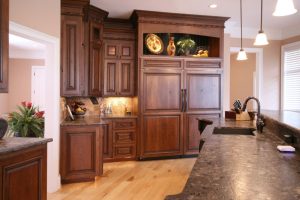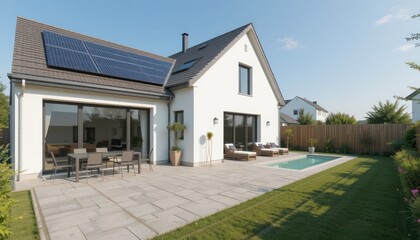A fresh surface can transform the heart of a room. Cabinet refinishing is more than a design choice; it is a process that blends artistry, craftsmanship, and sustainability into one purposeful act. It revives spaces without the heavy costs and waste of complete replacements, offering both aesthetic appeal and environmental responsibility. This practice is a quiet revolution in how people reimagine and personalize their living spaces.

At its core, cabinet refinishing is about restoration and reinvention. Instead of tearing out existing structures, it focuses on renewing their surfaces through cleaning, sanding, staining, painting, or sealing. This method breathes new life into old cabinets while preserving their foundational strength. It allows homeowners to update their interiors without discarding functional materials, a decision that benefits both their budget and the planet. Contact Cabinet Refinishing Modesto for professional help.
The process is as much about vision as it is about technique. It starts with evaluating the condition of the cabinets—assessing wear, damage, and the type of material involved. From there, decisions are made about finishes, colors, and textures that align with the desired look and feel. Each choice is an opportunity to express personality and style while adapting to current design trends or timeless aesthetics.
Cabinet refinishing has become increasingly popular due to its transformative power. A dated kitchen or worn storage unit can feel brand new with the right refinishing approach. Changing the color scheme, updating the hardware, or introducing a new texture can completely alter a room’s atmosphere. The result is a refreshed environment that reflects evolving tastes and modern sensibilities without the disruption of a full renovation.
Sustainability is another significant reason for the growing appeal of refinishing. By working with existing materials, the process reduces waste and minimizes the environmental impact associated with manufacturing and transporting new cabinetry. This approach supports eco-conscious living without compromising on design aspirations. In a world increasingly focused on resource conservation, refinishing offers a responsible alternative that aligns beauty with sustainability.
One of the most remarkable aspects of cabinet refinishing is its versatility. It suits a wide range of spaces, from kitchens and bathrooms to offices and storage areas. It can enhance traditional wooden cabinetry, modern laminated finishes, or even mixed-material designs. This adaptability ensures that almost any cabinet can be transformed to match new functional needs or evolving aesthetic preferences.
The craft also demands precision and skill. Proper preparation, including cleaning and sanding, is crucial to ensure the new finish adheres well and lasts for years. The application of stains, paints, or sealants must be even and deliberate to achieve a professional-quality result. Attention to detail during the final stages, such as polishing and hardware installation, can make the difference between a simple refresh and a stunning transformation.
The psychological impact of cabinet refinishing is often underestimated. People spend significant time in kitchens, offices, and living areas, and the look of these spaces influences their mood and productivity. Freshly refinished cabinets can make a space feel brighter, cleaner, and more welcoming. This improvement in environment often translates to improved well-being, reinforcing the value of investing in thoughtful design updates.
Economics also play a major role in the appeal of refinishing. Full cabinet replacement can be costly and time-consuming, involving demolition, construction, and new installations. Refinishing, by contrast, offers dramatic results at a fraction of the cost and with significantly less disruption. For many, it strikes the perfect balance between affordability and impact, delivering a high return on investment in terms of both property value and daily satisfaction.
The trends shaping cabinet refinishing continue to evolve with design culture. Minimalist approaches emphasize clean lines and muted tones, while bold color choices and textured finishes make striking statements. Matte surfaces, distressed looks, and natural wood grains are all popular ways to personalize a space. Each trend demonstrates how refinishing can adapt to contemporary tastes while remaining timeless in its appeal.
Advancements in materials and techniques are pushing the boundaries of what refinishing can achieve. Durable, low-VOC finishes enhance longevity while reducing environmental impact. Innovative coatings resist scratches, moisture, and UV damage, ensuring that refinished cabinets maintain their beauty for years. These innovations make refinishing a long-term solution, not just a temporary upgrade.
Refinishing also encourages creativity and experimentation. Some choose to blend finishes, combining painted sections with exposed wood for contrast. Others incorporate decorative techniques like glazing, antiquing, or two-tone color schemes to add depth and character. These artistic touches make each project unique, turning cabinetry into a focal point rather than a background element.
The emotional satisfaction of refinishing should not be overlooked. There is a deep sense of accomplishment in restoring something rather than discarding it. For many, the process becomes a personal project—a reflection of care, effort, and intention. The finished result carries a story of transformation, one that speaks to both creativity and resourcefulness.
In commercial spaces, cabinet refinishing offers practical advantages as well. Businesses can update interiors without long closures or high renovation costs. Retail stores, offices, and hospitality venues benefit from refreshed appearances that enhance customer experience and brand perception. This strategic investment can strengthen identity and competitiveness in an increasingly design-conscious marketplace.
As awareness of sustainable living grows, cabinet refinishing is likely to become an even more important design solution. It embodies principles of reuse and resourcefulness, showing that innovation does not always require starting from scratch. The approach aligns with broader movements toward circular economies, where existing materials are continually adapted and improved rather than discarded.
Future developments may introduce even more eco-friendly finishes, faster curing technologies, and automated application methods. These innovations will make refinishing more efficient, durable, and accessible to a wider audience. They will also expand the creative possibilities, allowing homeowners and designers to push beyond conventional styles.
In a world often obsessed with the new, cabinet refinishing stands as a reminder that renewal can be just as powerful as replacement. It is a practice that honors the value of what already exists while embracing the potential for transformation. Each brushstroke, stain, or seal is an act of reinvention that connects craftsmanship with creativity and sustainability.
Ultimately, cabinet refinishing is about more than updating furniture. It is about shaping environments that reflect changing lives, evolving identities, and deeper values. It is a practice that combines practicality with artistry, tradition with innovation, and function with beauty. In doing so, it offers a pathway to spaces that are not only more attractive but also more meaningful.
As homes and businesses continue to evolve, the significance of cabinet refinishing will only grow. It is a timeless craft with modern relevance, capable of adapting to future demands while staying true to its essence. In every refinished cabinet lies a story of renewal—a story that proves transformation is not just about replacing what is old but about revealing the potential that has always been there.

